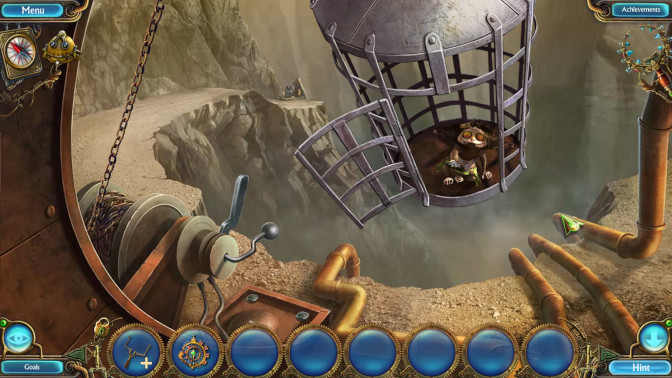|
Kingdom of Aurelia: Mystery of the Poisoned Dagger (Premium Edition)
Year Published: 2016
Publisher: Shaman Games Studio
Developer: Shaman Games Studio
|
Here is a very strange and confusing situation. I said in my review of the charming steampunk hidden object game, Namariel Legends: Iron Lord, that it seemed intended as the first in a series, but no sequels were ever made. That statement may have been in error, because 2016's Kingdom of Aurelia was very obviously meant to be a sequel. The character designs are the same, the story picks up right where Namariel Legends left off, and you even use the same mind-reading tool.
So, where's the confusion? Well, the names have all changed. The world is now "Aurelia" instead of "Namariel", resulting in a completely different title. Your robot helper Jim is now Tim, the woodcutter boy Tom is now Sam, Uncle Davincino is now Leonard (making it much more obvious he was named after Leonardo Da Vinci), and the Iron Lord is referred to as simply "the Tyrant". The previously unnamed heroine is now Princess Aurora, and you play as Tom/Sam instead of her because she's been poisoned by the titular dagger, and the goal is to save her.

That is totally the same robot centipede and totally Uncle Davincino tied up back there, but the game doesn't seem to want you to know that.
The question is, why all the name and title changes? Why the refusal to acknowledge the game is a sequel? Fans of Namariel Legends, like me, would not know this exists by searching its title. I found it by randomly picking a game in my Steam collection I hadn't played before. I was not expecting the familiar settings and robots to appear on my screen, and all the same characters with even the same voice actors.
This is so perplexing that a review threatens to become a series of speculations. It could be a copyright issue. A company called Playrix published Namariel Legends, and maybe they own the rights to that title and the character names. Developer Shaman Games Studio published Kingdom of Aurelia, so while they reused the same assets, they may not have been able to keep the names. It could also have been a marketing decision if Namariel Legends didn't sell very well to distance the two products. I don't know. It's strange and distracting. I would've thought a connection to a game with very positive reception would only help it sell more.

The view is nice, but doesn't have the same impact as the cockpit in Namariel.
While Namariel Legends fans may be happy to learn that a sequel of sorts does exist, they may be far less thrilled to discover that it goes through many of the same motions. Once again, Leonard (Davincino) is kidnapped, you seek the help of the forest seer, you end up onboard an airship, tangle with the same robotic centipedes, and meet the same forest giant and Mogwai-like "Benny" from the Dreamscapes series, all while chasing after a villain who is far less imposing or interesting than the Iron Lord. New characters, like a female sky pirate captain, are introduced then promptly disappear.
The story is overall less coherent, and as short as Namariel Legends was, Kingdom of Aurelia is shorter still. Take for example, the airship sequence, which is an abridged version of the same chapter in Namariel Legends. Namariel's dirigible had an outside view that demonstrated just how enormous it was. The view from the cockpit windows as the trees passed below was truly breathtaking. Aurelia's airship is smaller, has less to do, less to see, and the clouds zooming past the windows are nice, but not as impressive as those trees.

This is what much of the scenery looks like in this game: it's nice, but drab and brown. Namariel's lush greens are sorely missed.
The logic here applies to the rest of the game - doing the same things, but in less innovative environments. Both games have you stopping a fan to reach an item behind its blades. Both have a puzzle where you select countries on a spinning globe. Both have Leonard/Davincino getting kidnapped, but in Aurelia we don't know why. Apparently, even the villain doesn't know, as he eventually abandons him. There is nothing as memorable as Namariel's floating cat-like Woobies, and Ira, your squirrel/cat friend, is noticeable in her absence.
The villain's plan, from which the game takes its subtitle, is strangely abstract. The Iron Lord used a simple and effective strategy of conquering a medieval kingdom with higher technology. Marcus here (the airship captain from Namariel), poisons the princess with a cursed dagger. By next performing a ritual on the knife, he can control her like a puppet. It's awkward, especially in a series where automatons and zeppelins dot the landscape.

"Benny" helps out again, but where's Ira?
So, I'm not sure what to make of this. On the one hand, yay, there (kind of) is another Namariel Legends game, but on the other, it's a very scaled-down version of that game. Its insistence on pretending it isn't a sequel is irritating, as though I wouldn't notice these are literally the same characters and backstory. Ultimately, I'm left wondering why Kingdom of Aurelia was even made. As a sequel to Namariel Legends, it's derivative and disappointing. As a standalone game, it's well...same.
SCORE: 2.5/5
|





